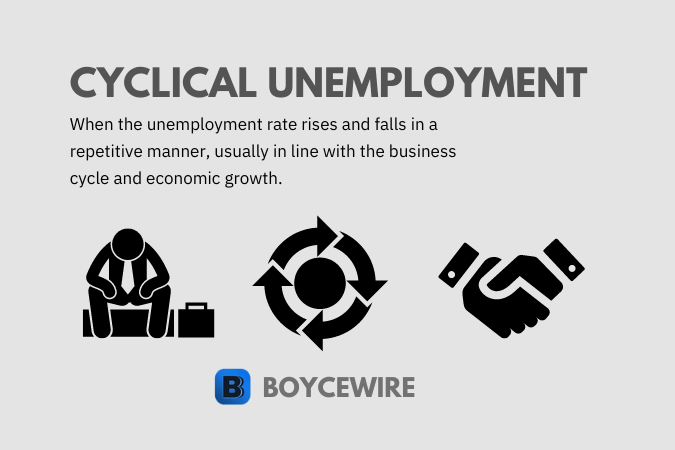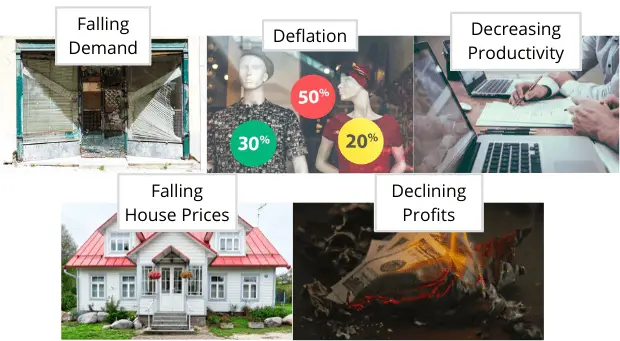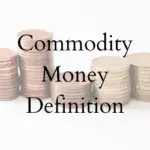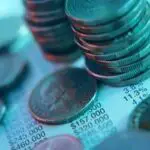Cyclical Unemployment: (What it is, 3 Causes & Example)

What is Cyclical Unemployment
Cyclical unemployment is where unemployment rises and falls in a reoccurring fashion. As a result of the ups and downs of economic growth, we see unemployment occur. When the economy is doing badly and losing jobs, this is known as cyclical unemployment – as it follows the business cycle of economic growth to contraction and back again.
Key Points
- Cyclical unemployment is fundamentally linked to economic growth and fluctuates in tandem.
- Also known as demand deficiency, cyclical unemployment is driven by falling consumer demand, leading to less demand for relevant jobs.
Cyclical unemployment tends to fluctuate alongside the business cycle as economic growth goes from a boom to a recession. Hence the term cyclical.
Cyclical unemployment is also known as demand deficiency. In other words, unemployment starts to rise as demand falls. This tends to happen to all economies across the world. Consumers start to spend less, perhaps because they are having a family or saving for a holiday in the future.
The problem lies when such a decline in demand happens all at the same time. In other words, many individuals all reduce their demand for many specific and personal reasons. In turn, this creates a lower demand for goods and services which also translates to lower demand for labor and employment.
We refer to this as cyclical because demand will pick up again and drive the economy and employment forward. So we can look at cyclical unemployment as following the aggregate demand of a nation.
Causes of Cyclical Unemployment

1. Decline in Demand
The main cause of cyclical unemployment occurs when demand throughout the economy declines. This happens on a macro basis, as demand in individual households falls all the time. So we are looking at a nationwide decline in demand. At least enough to contribute to businesses investing less and requiring fewer employees.
There will be occasions where individual households may need to reduce consumption to save for a new car or something else. However, cyclical unemployment occurs when many households end up doing this at the same time.
Once demand starts to fall, businesses don’t need to produce as many products or services, so start to reduce the number of workers they have. This may come in the form of redundancies or simply letting employees go without replacing them.
What’s more, there is a multiplier effect which makes initial declines in consumption more pronounced. Let’s look at that next.
2. Negative multiplier effects
The multiplier effect refers to the chain reaction that a reduction in demand has. For instance, a decline in demand for beef may not only affect the profits of the local supermarket or store, but also the farmer, the butcher, and those involved in transporting the goods.
So what looks like a decline in demand in one sector ends up affecting multiple areas. When we take this onto a wider scale, we may often see unemployment multiplying throughout each of the connected industries.
3. Market Crash
Recent market crashes such as that of 2007/08 and the dotcom crash in 2001/02 both contributed to causing cyclical unemployment. The financial effect was far-reaching. For instance, the dotcom crash was driven by technology firms spending too much too quickly, trying to reach the top.
Technology firms had high levels of debt which were only sustainable if high growth was achieved. When interest rates increased in 2000, it helped push many over the edge into bankruptcy. Consequently, the millions of people who were employed in such firms lost their jobs.
Market crashes tend not only to affect certain industries but also market confidence in general. So we often see a decline in employers looking to hire and expand as a level of uncertainty is created.
Effects of Cyclical Unemployment

The effect of cyclical unemployment can become self-fulfilling. When driven by falling demand, companies lay off workers and reduce investment. In turn, demand falls further and businesses can become less efficient due to failing to invest in productive capital.
1. Falling Demand
Cyclical unemployment occurs as a result of declining economic growth which is associated closely with falling consumer demand. As demand falls, businesses need fewer workers to meet that demand, leading to a decline in employment.
Consequently, as a result of declining consumer demand, people lose their jobs, which affects their demand and then effects the job of more people. So the original decline in demand can have far-reaching effects.
2. Deflation
When the economy declines and unemployment rises, we see lower consumer demand. This has to potential to contribute to deflation in the short-term. As consumers demand less, businesses may start reducing prices in order to attract customers back.
3. Declining Profits
As businesses face declining demand, they also face cost pressures. They may be forced to reduce the number of staff they have. This may involve paying redundancies as well as the inefficiency of keeping them on until they realise demand has fallen. They may also need to reduce prices to attract customers. Both of which have the potential to reduce profits.
4. Decreasing Productivity
Cyclical unemployment is driven by an economic decline which is also accompanied by falling consumer demand. Consumers are demanding less which means businesses tend to make less money. Consequently, we see businesses looking to cut costs rather than investing in more productive machinery and capital.
At the same time, many businesses will find themselves overstaffed due to the decline in demand. For instance, there may be 5 waitresses on duty, but there are only enough customers to require 3. The other 2 are left fiddling their thumbs.
5. Falling House Prices
During economic recessions and cyclical unemployment, there is also a trend for house prices to also fall. With people losing their jobs and general demand falling, the bargaining power of sellers equally diminishes.
Those who can afford to buy have the upper hand. At the same time, those who lost their jobs may be in dire need to downsize in order to protect their capital invested in their house.
Cyclical Unemployment Example
Cyclical unemployment occurs in certain industries more predominantly than others. For instance, house builders tend to suffer due to a decline in both demand and ability to afford new homes.
At the same time, industries that could be classified as ‘luxury goods’ are also negatively affected. The likes of airlines, hospitality, and to a certain extent, restaurants, all face downwards pressures during cyclical unemployment.
To take an example of cyclical unemployment, we can look at the last twenty years. The first cyclical unemployment occurred in the US back in 2000. The US entered a technical recession, registering two-quarters of negative economic growth, driven by the dotcom crash.
The recession was rather mild, with unemployment increasing in the subsequent years. The recovery was almost non-existent, as unemployment never reached the same levels it did in 2000. At least before the world was rocked by the financial crisis in 2008.
Unemployment rose as the economy tanked, showing a clear example of cyclical unemployment.
Solutions to Cyclical Unemployment
Cyclical unemployment occurs as a result of declining and rising economic growth. It is driven predominantly by consumer demand, which is accounts for between 60 and 70 percent in most developed nations. So consumer demand can be a significant contributor in creating such fluctuations.
There are two main tools by which governments try to use to ‘solve’ cyclical unemployment. They are expansionary fiscal policy and expansionary monetary policy. Let us look at what they do below:
1. Expansionary Fiscal Policy
Expansionary fiscal policy comes in two forms. Increased government spending, or, lower taxation.
Government Spending
By increasing government spending, the government is borrowing money from tomorrow, to use today. That means higher taxes in the long run.
Its effectiveness was highly lauded by economist John Maynard Keynes. He stated that the government should step in to prevent cyclical unemployment and declining aggregate demand.
The logic behind such is that the government would spend money. Whether it’s infrastructural projects, government-driven employment programs, or increasing welfare payments. In turn, that money would filter into the wider economy and therefore prevent such a dramatic decline in demand.
The main problem with this is that it can starve the private sector of funding. By increasing government spending, it must come from either public taxation or debt. Either way, there is less for private individuals to spend how they see fit.
Instead, the government is deciding where the money ought to go. Now that might be a good thing during an economic recession but does not provide a stimulating environment for growth. So we can find ourselves dependent on the government to drive growth as private entities are starved of capital.
Reduced Taxation
When governments reduce taxation, the aim is to put more money into the pockets of individuals. The theory is that as consumers are taxed less, they have greater disposable income. So imagine having an extra $200 each month.
Some of us may spend that extra income, whilst some of us may save it instead. So it can have a stimulating effect on the wider economy but depends on how the average consumer reacts.
If everyone spent 100 percent of the additional income they received from tax cuts, the economy would see a significant boost in consumer demand. Depending on the extent of the cuts, it may very well stave off cyclical unemployment. However, the reality is quite different.
Recessions always come alongside declining consumer confidence. Consumers are losing jobs and those who don’t may become fearful that they might. So in turn, we see a more cautious public.
We may also see the public save every penny they gain from lower taxes. However, that is equally unlikely. What happens most of the time is somewhere in between. So it doesn’t have the positive effect most governments predict, but neither does it have no effect.
2. Expansionary Monetary Policy
Expansionary monetary policy is employed by central banks, usually in order to control the inflation rate, as well as the rate of unemployment and economic growth. It does so by using several monetary tools.
Quantitative Easing
First of all, we have quantitative easing (QE), which is used to increase the supply of money. Central banks create money and buy government debt from financial institutions.
This injects money into the private market, which tends to increase the availability of credit to both consumers and business. Although, as we saw in 2008, banks used quantitative easing to boost their reserves rather than lend it out. So serious was the financial strain, banks couldn’t afford to lose liquid capital by lending it out.
Nevertheless, the creation of capital by central banks generally filters down into the wider economy. By buying government debt from financial institutions, they have more money to lend out. That means greater availability of credit to Mr. Relad who wants to extend his house. And it also means greater availability to Bobs Bicycles that want to expand its business.
At the same time, QE creates greater stability in the asset market. By creating demand for government debt, it helps restrict the relative price movements of other assets such as stocks and bonds. This stability can help reduce the panic and store business confidence enough to continue to invest.
QE aims at stimulating the economy by injecting cash into it. With more cash going through the economy, people will have more and that will stimulate demand. In turn, businesses will see demand pick up and start employing more people. At least that is how it works in theory.
In reality, the funds don’t filter down significantly enough to benefit the wider economy. The most common outcome is that financial assets become ever more inflated.
Interest Rates
One of the most common uses of expansionary monetary policy is the use of the central banks’ base rate. Essentially, this rate influences what rate banks lend at, and what consumers and businesses borrow at. It ranges from the general credit card rates to mortgages and business loans. So it can be very influential, especially for those on variable rates.
When rates go down, it can create a ripple through the economy that benefits those who rely on credit. Consumers with ‘tracker rate mortgages’ will benefit from lower rates. It creates a greater level of income for them which can lead to greater consumption in the economy and improve unemployment.
Businesses end up spending less on interest, which also means that there are more funds for other investments or employment opportunities.
Cyclical Unemployment FAQs
Cyclical unemployment is type of unemployment that occurs as a result of the ups and downs of the business cycle. The main cause is from a drop in demand for goods which leads to a decrease in production and need for workers.
Cyclical unemployment might occur due to either declining demand, a negative multiplier effect, or a market crash. For example, a higher number of workers are required in retail during the festive period. Farmers also require more labourers during the harvest period. However, when these seasonal trends are over, the demand for such employees declines.
Cyclical unemployment can occur due to the ups and downs of the business cycle. For example, luxury goods tend to see a decline in demand during recessionary periods as consumers tighten their budgets.
Cyclical unemployment refers to the up and down in unemployment rate, which tends to fluctuate alongside the health of the economy. By contrast, natural unemployment is seen as a ‘normal’ rate of unemployment. In other words, it is the set rate by which unemployment creates a stable economic environment.
Policymakers can use a number of fiscal and monetary tools to address cyclical unemployment. For example, governments may look to cut taxes to stimulate falling demand, or increase public investment to create more jobs. Alternatively, central banks may use monetary tools such as lower interest rates to encourage borrowing and investment. The aim of which is to boost demand and therefore prevent the resulting economic decline and unemployment.
About Paul
Paul Boyce is an economics editor with over 10 years experience in the industry. Currently working as a consultant within the financial services sector, Paul is the CEO and chief editor of BoyceWire. He has written publications for FEE, the Mises Institute, and many others.

Related Topics
Further Reading
 Commodity Money: What it is, Why it has value & Examples - We can define Commodity money as a physical good that consumers universally use to trade for other goods. In other…
Commodity Money: What it is, Why it has value & Examples - We can define Commodity money as a physical good that consumers universally use to trade for other goods. In other…  Porter’s 5 Forces: Definition, Model & Example - Porters 5 forces is a method used to breakdown and understand the competitive nature of an industry or business.
Porter’s 5 Forces: Definition, Model & Example - Porters 5 forces is a method used to breakdown and understand the competitive nature of an industry or business.  Average Fixed Cost - Table of Contents What is an Average Fixed Cost? Understanding Average Fixed Cost Formula Average Fixed Cost Curve Advantages Disadvantages…
Average Fixed Cost - Table of Contents What is an Average Fixed Cost? Understanding Average Fixed Cost Formula Average Fixed Cost Curve Advantages Disadvantages… 
